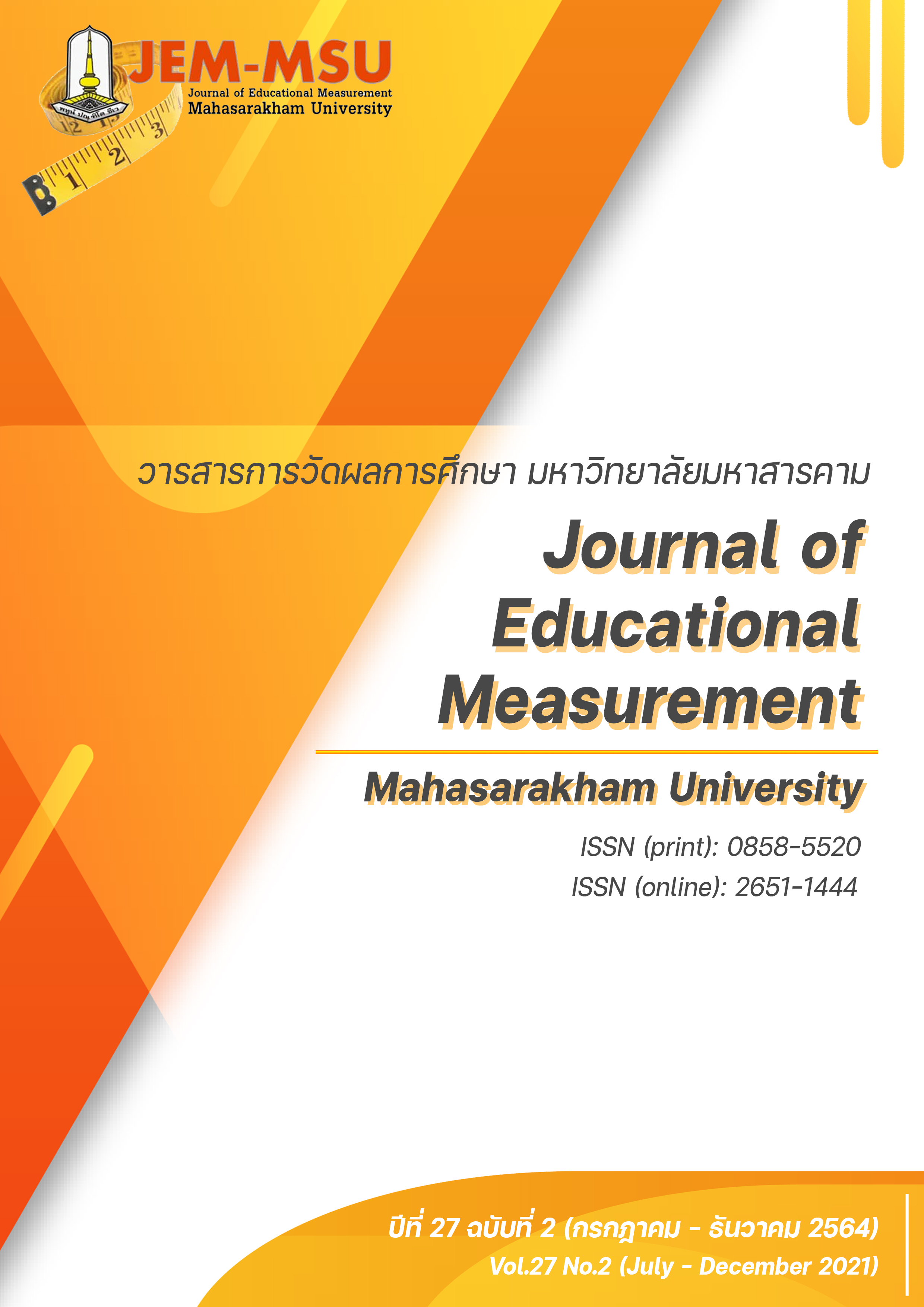Results of Assessment of Using Different Reflective Thinking Forms of Collaborative Problem-Solving Ability and Product Quality of Lower Secondary School Students
Main Article Content
Abstract
The objectives of this research were to 1) compare the collaborative problem- solving abilities of the lower secondary school students participating in self-assessment activities using different reflective thinking forms, 2) compare the pre-participation collaborative problem-solving abilities with post-participation collaborative problem-solving abilities of lower secondary school students after participating in the activities using different reflective thinking forms, and 3) compare the product qualities of the lower secondary school students participating in self-assessment activities using different reflective thinking forms. The sample consisted of 42 lower secondary school students of Dongklangpattanasuka School in Thakhantho District, Kalasin Province in the second semester of the academic year 2019, selected through purposive sampling. The research instruments used with the students of the experimental group were 1) a collaborative problem-solving ability scale, 2) an evaluation form for students' product quality based on the criteria of analytic scoring rubric, 3) 3 lesson plans of collaborative problem-solving with 4 hours allotted for each plan, totaling 12 hours, and 4) a self-assessment form using reflective thinking forms consisting of a rating scale, an open-ended questionnaire and a journal. Data were analyzed by using descriptive statistics, Wilcoxon Matched Pairs Signed-Rank Test and Kruskal-Wallis Test.
The findings were as follows:
1) The collaborative problem-solving abilities of lower secondary school students completing self-assessment using different reflective thinking forms were not different.
2) The collaborative problem-solving abilities of lower secondary school students using different reflective thinking forms after participating in the activity of self-assessment using reflective thinking forms were different, with statistical significance at the .05 level, as the post-participation collaborative problem-solving abilities were higher than the pre-participation abilities.
3) The lower secondary school students participating in the self-assessment activities using different reflective thinking forms had different product qualities, with statistical significance at the .05 level. The students with self-assessment activities using the open-ended questionnaire had the product quality scores higher than those using the rating scale and the journal, respectively.
Article Details
The content and information contained in the published article in the Journal of Educational Measurement Mahasarakham University represent the opinions and responsibilities of the authors directly. The editorial board of the journal is not necessarily in agreement with or responsible for any of the content.
The articles, data, content, images, etc. that have been published in the Journal of Educational Measurement Mahasarakham University are copyrighted by the journal. If any individual or organization wishes to reproduce or perform any actions involving the entirety or any part of the content, they must obtain written permission from the Journal of Educational Measurement Mahasarakham University.
References
โครงการ PISA ประเทศไทย สถาบันส่งเสริมการสอนวิทยาศาสตร์และเทคโนโลยี. (2556). ผลการประเมิน PISA 2012 การอ่าน คณิตศาสตร์ และวิทยาศาสตร์ บทสรุปเพื่อการบริหาร. กรุงเทพฯ: อรุณการพิมพ์.
ชมพูนุช จันทร์แสง. (2554). ผลของการประเมินตนเองโดยใช้วิธีการสะท้อนคิดที่แตกต่างกันที่มีต่อความสามารถในการคิดอย่างมีวิจารณญาณ ของนักเรียนชั้นมัธยมศึกษาปีที่ 5 (วิทยานิพนธ์ปริญญา ครุศาสตรมหาบัณฑิต), จุฬาลงกรณ์มหาวิทยาลัย.
นิดา ชาญบรรยง. (2555). สถิติการวางแผนการทดลอง (เอกสารประกอบการสอน). ภาควิชาสถิติ มหาวิทยาลัยเกษตรศาสตร์.
ปรณัฐ กิจรุ่งเรือง. (2560).การพัฒนารูปแบบการสอนโดยใช้กรณีศึกษาทางศาสตร์การเรียนการสอนเพื่อส่งเสริมความสามารถด้านการคิดอย่างมีวิจารณญาณของนักศึกษาวิชาชีพครู. (วิทยานิพนธ์ปริญญาดุษฎีบัณฑิต). มหาวิทยาลัยศิลปากร.
ปารมี ตีรบุลกุล. (2557). อิทธิพลของการปฏิบัติงานแบบสะท้อนคิดและความสามารถด้านการนิเทศที่มีต่อการวิจัย ปฏิบัติการในชั้นเรียนของนิสิตนักศึกษา ครูโดยมีการแก้ปัญหาเชิงสร้างสรรค์เป็นตัวแปรส่งผ่าน (วิทยานิพนธ์ปริญญาครุศาสตรมหาบัณฑิต), จุฬาลงกรณ์มหาวิทยาลัย.
อวยพร เรืองตระกูล และสุนทรพจน์ ดำรงพานิช. (2551). การประเมินตนเองเพื่อการพัฒนา. เติมเต็มความรู้ :รู้คิด-รู้ทำ, 1-26.
Griffin, P., McGaw, B., & Care, E. (Eds.). (2012). Assessment and teaching of 21st century skills. Dordrecht: Springer.
Heilenman, L.K. (1990). Self-assessment of second language ability: The role of response effects. Language Testing, 7(2), 174-201.
Kemery, E. R., & Stickney, L. T. (2013). A multifaceted approach to teamwork assessment in an undergraduate business program. Journal of Management Education, 38(3), 462-479.
Strough, J., Berg, C. A., & Meegan, S. P. (2001). Friendship and gender differences in task and social interpretations of peer collaborative problem solving. Social Development, 10(1), 1–22.
OECD. (2013). PISA 2015: Draft collaborative problem solving framework. Paris: OECD.
Ohland, M. W., Layton, R. A., Loughry, M. L., & Yuhasz, A. G. (20012). Effects of behavioral anchors on peer evaluation reliability. Journal of Engineering Education, 94, 319-326.


